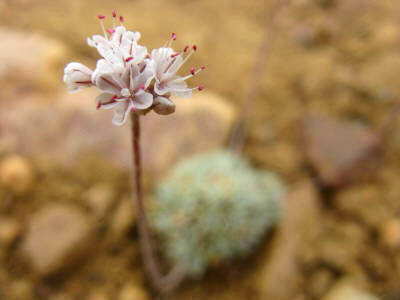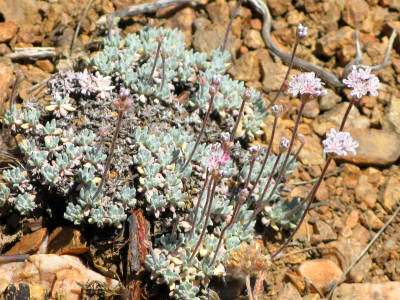Eriogonum kennedyi var. austromontanum
- Threatened – Endangered Species Act (1998)
- Rare Plant Rank 1B.2 – California Native Plant Society
- T2 Imperiled – NatureServe (1989)
Southern mountain buckwheat is a unique and rare plant found solely in the Los Padres and San Bernardino national forests. Specifically in the Los Padres National Forest, it has been found around Lockwood Valley and the area around Thorn Meadows, Mutau Flat and the Piano Box Loop, at elevations above five thousand feet. Listed as threatened under the federal Endangered Species Act in 1998, the southern mountain buckwheat remains vulnerable to several threats.
The Plant
Southern mountain buckwheat is a woody-based perennial plant with stems forming loose cushion-like leafy mats covered by dense white hair. The flower clusters are about 3-6 inches high and a white to rose color, blooming between June and September.
Southern mountain buckwheat typically occurs in “pebble plains.” These areas are characteristically treeless openings within the forest with extremely low infiltration rates and high runoff potentials. The buckwheat particularly likes rocky sites in the pebble plains and is often found neighboring bear valley sandwort.
It produces seeds by self-pollination and insect pollination by wasps, bees and flies.
Threats
The creation of Big Bear Lake in the 1880s destroyed some of the original pebble plain habitat of southern California. Development around the lake and surrounding areas continues to impact important habitat for the Southern mountain buckwheat.
Illegal off-highway vehicle (OHV) trespass, road maintenance activities, and other motorized and mechanized vehicles have degraded pebble plain habitat. Trampling and vegetation clearing associated with illegal target shooting threatens the species. Furthermore, special use permits issued by the Forest Service in the pebble plains for other activities such as mining and recreation have exasperated the habitat degradation. As habitat degrades the classic problem of invasive species invasion comes into play, and native plants like the buckwheat are soon competing with out-of-towners like cheatgrass. Livestock grazing has also been documented as detrimental to the species. And finally, wildland fires and preventive emergency fuelbreak construction both have potential to negatively impact the southern mountain buckwheat and its limited pebble plain habitat.
Conservation
Southern mountain buckwheat was federally listed as threatened under the Endangered Species Act on September 14, 1998. At the time these plants were federally listed, the U.S. Fish & Wildlife Service determined that designation of critical habitat for this and two other pebble plain species was not necessary. Thus in 2004, conservation organizations filed a joint lawsuit challenging the agency’s failure to designate critical habitat, a requirement of the Endangered Species Act. Because of that case, critical habitat was finally designated in 2007 and protects 904 acres of habitat for the southern mountain buckwheat in the San Bernardino National Forest.
These critical habitat protections do not extend to the Los Padres populations, as the plant was only recently discovered here. The U.S. Fish & Wildlife Service is currently reviewing the status of southern mountain buckwheat to determine whether additional protective measures are needed.
Unfortunately, populations of the Southern mountain buckwheat on national forest land remain vulnerable and are declining, though the rate of decline has been reduced through various conservation measures like the critical habitat designation in 2006 and the recent completion of the Pebble Plain Habitat Management Guide. Implementation of recommended protection measures, an increase in public education, and further research will also help the species. Barriers and signs have been installed around the buckwheat’s habitat to direct recreational use and to educate the public as to why conservation measures are needed. Additionally, eight road segments directly affecting pebble plain habitat were decommissioned in 1999, and some special use permits have been discontinued and events relocated to decrease habitat degradation.
Through proper forest conservation and resource management, the Forest Service, in cooperation with local conservation groups like Los Padres ForestWatch, can help ensure this species’ survival.








